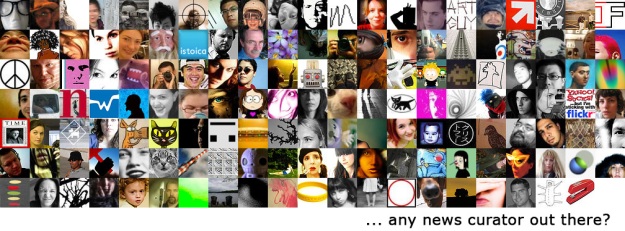Your news audience in Twitter – Discover your curators
@SNOW/WWW, 2013, by Janette Lehmann, Carlos Castillo, Mounia Lalmas, and Ethan Zuckerman
Original post at WWW Workshop on Social News on the Web
Information between journalists and their audience in social media flows in both ways. A recent study from the Oriella PR Network showed that over 54% of journalists use online social media platforms (Twitter, Facebook, and others) and 44% use blogs to find new story angles or verify the stories they work on. There are now platforms, such as Storyful, that provide user lists of high quality, developed by journalists for journalists.
Our starting point is the community of engaged readers of a news story — those who share a particular news article through Twitter. We refer to them as a transient news crowd, in analogy with the group of passers-by that gathers around unexpected events such as accidents in a busy street. The question is whether the users of such a crowd can provide further valuable information related to the story of the news article.
Many members of news crowds are far from being passive in their consumption of news content. They are news curators, because they filter, select, and disseminate carefully selected news stories about a topic.
A famous example for this type of news curator is Andy Carvin (@acarvin), who mostly collects news related to the Arabic world. He became famous for his curatorial work during the Arab Spring, where he aggregated reports in real time and tweeted up to thousands of tweets per day. We expect that among the users who share an article in Twitter are also other curators like Andy Carvin who may follow-up with further tweets.
We have observed that basically all news stories have a set of Twitter users who may be potential news curators for the topics of the story. For instance, among the people who tweeted the Al Jazeera’s article “Syria allows UN to step up food aid” (posted January 2013), there are at least two news curators: @RevolutionSyria and @KenanFreeSyria.
However, not everybody can be considered a news curator. Some people tweet one piece of news that was interesting to them and move on. Others tweet a wide range of news stories. Curators are individuals who carefully follow a story or related set of stories. In our SNOW 2013 work “Finding News Curators in Twitter”, we defined a set of features for each user and demonstrated that they can be used to automatically find relevant curators among the audience. The features describe the visibility, tweeting activity and the topical focus of a user. We collected news articles published in early 2013 of BBC World Service (BBC) and Al Jazeera English (AJE). Then, we followed the users that posted a specific article and analyzed their tweeting behavior. Our results reveal that 13% of the users from AJE and 1.8% of the users from BBC world are possible news curators.
The roles of curators in a crowd…
Some news curators are more focused than others. For instance, @KeriJSmith, a self-defined “internet marketer” tweets about various interesting news on a large variety of topics, while others are more selective. A famous example is Chan’ad Bahraini (@chanadbh) who tweets about Bahrain. Whether a user is topic-focused or not can be determined, for instance, by the number of different sections of a news web site s/he is tweeting about. If these sections differ (e.g. from finance to celebrities), we can assume that the user is less focused.
Considering only the topical focus of a user is not sufficient when identifying story curators. A significant amount of Twitter accounts operate as news aggregators – collecting news articles automatically (e.g. from RSS feeds) and posting their corresponding headlines and URLs to Twitter (45% in Al Jazeera English, 65% in BBC world). They can be identified easily, as most or all of their tweets contain URLs and they do not tend to interact much via messages with other users.
The majority of news aggregators post many tweets per day related to breaking news and top stories, e.g. @BreakingNews. Only a minority is focused on more specific topics, and thus constitutes topic-focused aggregators. The user @RevolutionSyria, for instance, distributes automatically news articles about the civil war in Syria. Whether the automatic generated tweets provide interesting content to a topic is questionable. Nonetheless, some news aggregators seem to be considered valuable by users, as in the case of @RevolutionSyria who has around 100,000 followers at the time of this writing.
In short, our current research deals with identifying crowds, curators, and aggregators. For more details you can check our articles and presentations:
- Janette Lehmann, Carlos Castillo, Mounia Lalmas and Ethan Zuckerman: Finding News Curators in Twitter. To be presented at the WWW Workshop on Social News On the Web (SNOW), Rio de Janeiro, Brazil.
- Janette Lehmann, Carlos Castillo, Mounia Lalmas and Ethan Zuckerman: Transient News Crowds in Social Media. To be presented at the Seventh International AAAI Conference on Weblogs and Social Media (ICWSM), 8-10 July 2013, Cambridge, Massachusetts.
Photo credits: Hobvias Sudoneighm (Creative Commons BY).

